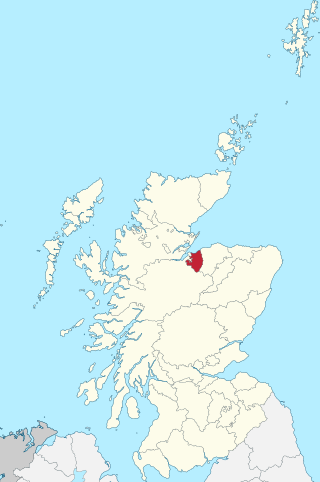
The County of Moray, or Morayshire, called Elginshire until 1919, is a historic county in Scotland. The county town was Elgin. The historic county ceased to be used for local government purposes in 1975. Since 1996 most of the historic county's area has been included in the Moray council area. The historic county boundaries are still used for certain functions, being a registration county. There is also a Moray lieutenancy area, covering a slightly smaller area than the historic county. The historic county borders Nairnshire to the west, Inverness-shire to the south, and Banffshire to the east, and has a coast onto the Moray Firth to the north.

Earl of Leven is a title in the Peerage of Scotland. It was created in 1641 for Alexander Leslie. He was succeeded by his grandson Alexander, who was in turn followed by his daughters Margaret and Catherine. Thereafter, there was a dispute relating to succession to the title between David Melville and John Leslie, 1st Duke of Rothes. However, in 1681, Melville's claim was admitted after the Duke of Rothes died. In 1707, Melville succeeded to the title Earl of Melville, and thereafter the earldoms have been united.

The County of Nairn, or Nairnshire, is a historic county, registration county and lieutenancy area of Scotland. The county was used for local government until 1975 when the area was redesignated as the Nairn District, one of the eight districts of the two-tier Highland region. Nairn district was abolished in 1996 when Highland became a single-tier council area.
The Lord Lieutenant of Angus, is the British monarch's personal representative in an area which was defined by the Lord-Lieutenants (Scotland) Order 1996 as consisting of the unitary Angus council area, in Scotland.
The Lord-Lieutenant of Inverness is the British monarch's personal representative in an area which has been defined since 1975 as consisting of the local government districts of Inverness, Badenoch and Strathspey, and Lochaber, in Scotland, and this definition was renewed by the Lord-Lieutenants (Scotland) Order 1996. The area of the lieutenancy used to be the county of Inverness, which was abolished as a local government area by Local Government (Scotland) Act 1973. The districts were created, by the 1973 act, as districts of the two-tier Highland region and abolished as local government areas under the Local Government etc. (Scotland) Act 1994, which turned the Highland region into a unitary council area.

Brodie can be a given name or a surname of Scottish origin, and a location in Moray, Scotland, its meaning is uncertain; it is not clear if Brodie, as a word, has its origins in the Gaelic or Pictish languages. In 2012 this name was the 53rd most popular boys' name in Scotland. The given name originates from the surname.

Clan Brodie is a Scottish clan whose origins are uncertain. The first known Brodie chiefs were the Thanes of Brodie and Dyke in Morayshire. The Brodies were present in several clan conflicts, and during the civil war were ardent covenanters. They indirect involvement in the Jacobite uprising of 1715, and none with that of 1745. Some members of the family worked for the British East India Company in the 18th Century.
This is a list of people who have served as Lord-Lieutenant of Kirkcudbright, part of the Dumfries and Galloway council area of south-west Scotland. Prior to 1975 the lieutenancy corresponded to the historic county of Kirkcudbrightshire. Since 1975 the lieutenancy area has been the slightly smaller Stewartry district, corresponding to the local government district of Stewartry established in 1975 and abolished in 1996. From 1975 until 1996 the title was the "Lord-Lieutenant for Dumfries and Galloway Region ". In 1996 the title was changed to "Lord-Lieutenant for the Stewartry of Kirkcudbright".
The Lord Lieutenant of Caithness is the British monarch's personal representative in an area defined since 1975 as consisting of the local government district of Caithness, in Scotland. This definition was renewed by the Lord-Lieutenants (Scotland) Order 1996. Previously, the area of the lieutenancy was the county of Caithness, which was abolished as a local government area by the Local Government (Scotland) Act 1973. The district was created under the 1973 act as a district of the two-tier Highland region and abolished as a local government area under the Local Government (Scotland) Act 1994, which turned the Highland region into a unitary council area.
This is a list of people who have served as Lord Lieutenant of Wigtown, part of the Dumfries and Galloway council area of south-west Scotland. Prior to 1975 the lieutenancy area corresponded to the historic county of Wigtownshire. Since 1975 the lieutenancy area has been the slightly larger Wigtown Area, covering the historic county plus the two parishes of Kirkmabreck and Minnigaff from Kirkcudbrightshire.

Nairnshire was a county constituency of the House of Commons of Great Britain from 1708 until 1800, and of the House of Commons of the United Kingdom from 1801 to 1832.

Kilravock Castle is located near the village of Croy, between Inverness and Nairn, in the council area of Highland, Scotland. It was begun around 1460 and has been the seat of the Clan Rose since that time. The castle is a composite of a 15th-century tower house and several later additions. The original name for the castle was Cill Rathaig; Scottish Gaelic meaning "church at the small circular fort".
In 1128, the cousin of St Bernard of Clairvaux, Hugues de Payens, met King David I in Scotland. The Order established a seat at Balantrodoch, now Temple, Midlothian on the South Esk. In 1189, Alan FitzWalter, the 2nd Lord High Steward of Scotland was a benefactor of the Order.
Archibald Alexander Leslie-Melville, 13th Earl of Leven, 12th Earl of Melville KT DL was a Scottish soldier, and peer.
Alexander Robert Leslie-Melville, 14th Earl of Leven DL was a Scottish peer and soldier.
Nairnshire was a constituency of the Parliament of Scotland before the Union with England in 1707. The barons of the shire or sheriffdom of Nairn elected two commissioners to represent them in the Parliament and in the Convention of Estates.
Lieutenant-General Duncan James Baillie was a Scottish first-class cricketer and British Army officer.

Hugh Rose, 20th Baron of Kilravock (1781-1827) was a Member of Parliament for Nairnshire and Chief of Clan Rose. The eldest son of Hugh Rose of Brea and Broadley and his wife Elizabeth Rose, Lady of Kilravock, he inherited his mother's estates and the Clan Chiefdom on her death in 1815.

Major James Rose, 23rd Baron of Kilravock (1820-1909) was a British Army officer serving in British India, the Lord Lieutenant of Nairn and the Chief of Clan Rose. The third surviving son of Hugh Rose, 20th of Kilravock by his second wife, Catherine Mackintosh of Farr.

Lt Col Hugh Rose, 24th Baron of Kilravock (1863–1946) was a decorated British Army officer serving in the Black Watch, rising to become Lieutenant Colonel of the 1st Battalion, Black Watch. Rose was also the Chief of Clan Rose and a Deputy Lieutenant and Justice of the Peace of the County of Nairn.






